#the human scientists testify
Explore tagged Tumblr posts
Note
Regarding the former Decepticon Scientist turned Foodtruck oc, with the arrival of the Elite Guard, Optimus or Ratchet might have let slip that they were currently on the planet and spent the last several vorns living peaceful on the Earth.
How would the Elite Guard react to hearing about the former scientists living on an organic planet to become a "sustenance provider for organics"?
-Ultra Magnus remembers the scientist all too well. Oh, he never met them in person but he saw for himself the destruction caused by their weapons. Many of his comrades died to those weapons. He's wanted to bring them to justice for years now. That's why, no matter what the autobots on Earth have to say about "redemption" and "rehabilitation", Magnus is going to arrest the con and drag them back to Cybertron. He will hold a trial and he will make sure that they are found guilty of every single charge. Magnus won't be satisfied until the con is in a windowless cell.
-Sentinel laughs at the con, straight in their face. Oh, he's heard of them, of what they did to all those autobots back during the war. He used to think they were a monster. That they were frightening. Now he just thinks they are pathetic. At least back then they used to be someone. A filthy decepticon, sure, but they had status. Power. Now? They make slop for disgusting organics. A fitting punishment, he suppose. But he's still going to bring them back to Cybertron for questioning and a trial. The higher ups will love him for it.
-Jazz doesn't believe it at first. Listen, he's read about this decepticon. The weapons they created were nothing short of devastating. They were such a high ranking decepticon too, up there with the worst. And now they're on Earth, apparently fully changed and happily making food for humans? It's... hard to believe. But Jazz forces himself to observe, even when part of him wants to handcuff them the very moment he first lays optics on them. So he watches. And watches some more. And nothing. There's no secret evil plot, no villainous scheme. The bot has truly turned over a new leaf. They regret what they did and want nothing more than to repent. They are a new mech.
So what is Jazz supposed to do now? The lawful thing to do would be bringing them back to Cybertron, to put them on trial. He could even testify for them, tell everyone what he saw. But he's not sure people would listen. Another choice is to leave them on Earth. The war is long over. They have turned their back on the decepticons. They pose no danger to anyone. But is that the right thing to do? Jazz does not know. He wants to think so though.
-Jetfire and Jetstorm are prepared to face a monster when they go to confront the ex-decepticon. They prepare for a real fight. But when they get there, they just see an old foodtruck, giving food to humans. At first they assume the food is poisoned. Look out humans! But then the customers reveal that they have been eating the food for decades and they feel fine. Huh. Well, the con is probably just trying to earn enough money to start a business empire so they can enslave mankind! What? The food is free? Ehhhhhh. Now the twins are confused. And the ex-con does not appear to want to fight either. Should they just... bring them back to the ship? Get them back to Cybertron for a trial? But everyone looks so happy! The humans with their food and the ex-con doing charity work. Maybe... they can just leave them here? They will keep an eye on the ex-con though! Just in case. But this should be fine too.
#transformers imagine#transformers animated#ultra magnus#sentinel prime#jazz#jetfire#jetstorm#jettwins
55 notes
·
View notes
Text
Carl Sagan’s scientific legacy extends far beyond ‘Cosmos’

by Jean-Luc Margot, Professor of Earth, Planetary, and Space Sciences at the University of California, Los Angeles
On Nov. 9, 2024, the world will mark Carl Sagan’s 90th birthday – but sadly without Sagan, who died in 1996 at the age of 62.
Most people remember him as the co-creator and host of the 1980 “Cosmos” television series, watched worldwide by hundreds of millions of people. Others read “Contact,” his best-selling science fiction novel, or “The Dragons of Eden,” his Pulitzer Prize-winning nonfiction book. Millions more saw him popularize astronomy on “The Tonight Show.”
What most people don’t know about Sagan, and what has been somewhat obscured by his fame, is the far-reaching impact of his science, which resonates to this day. Sagan was an unequaled science communicator, astute advocate and prolific writer. But he was also an outstanding scientist.
Sagan propelled science forward in at least three important ways. He produced notable results and insights described in over 600 scientific papers. He enabled new scientific disciplines to flourish. And he inspired multiple generations of scientists. As a planetary astronomer, I believe such a combination of talents and accomplishments is rare and may occur only once in my lifetime.
Scientific accomplishments
Very little was known in the 1960s about Venus. Sagan investigated how the greenhouse effect in its carbon dioxide atmosphere might explain the unbearably high temperature on Venus – approximately 870 degrees Fahrenheit (465 degrees Celsius). His research remains a cautionary tale about the dangers of fossil fuel emissions here on Earth.
Sagan proposed a compelling explanation for seasonal changes in the brightness of Mars, which had been incorrectly attributed to vegetation or volcanic activity. Wind-blown dust was responsible for the mysterious variations, he explained.

Sagan and his students studied how changes to the reflectivity of Earth’s surface and atmosphere affect our climate. They considered how the detonation of nuclear bombs could inject so much soot into the atmosphere that it would lead to a yearslong period of substantial cooling, a phenomenon known as nuclear winter.
With unusual breadth in astronomy, physics, chemistry and biology, Sagan pushed forward the nascent discipline of astrobiology – the study of life in the universe. Together with the research scientist Bishun Khare at Cornell University, Sagan conducted pioneering laboratory experiments and showed that certain ingredients of prebiotic chemistry, called tholins, and certain building blocks of life, known as amino acids, form naturally in laboratory environments that mimic planetary settings.

He also modeled the delivery of prebiotic molecules to the early Earth by asteroids and comets, and he was deeply engaged in the biological experiments onboard the Mars Viking landers. Sagan also speculated about the possibility of balloon-shaped organisms floating in the atmospheres of Venus and Jupiter.
His passion for finding life elsewhere extended far beyond the solar system. He was a champion of the search for extraterrestrial intelligence, also known as SETI. He helped fund and participated in a systematic search for extraterrestrial radio beacons by scanning 70% of the sky with the physicist and electrical engineer Paul Horowitz.
He proposed and co-designed the plaques and the “Golden Records” now affixed to humanity’s most distant ambassadors, the Pioneer and Voyager spacecrafts. It is unlikely that extraterrestrials will ever find these artifacts, but Sagan wanted people to contemplate the possibility of communication with other civilizations.
youtube
Carl Sagan, offering his unique commentary in a scene from ‘Cosmos.’
Advocacy
Sagan’s scientific output repeatedly led him to become an eloquent advocate on issues of societal and scientific significance. He testified before Congress about the dangers of climate change. He was an antinuclear activist and spoke out against the Strategic Defense Initiative, also known as “Star Wars.” He urged collaborations and a joint space mission with the Soviet Union, in an attempt to improve U.S.-Soviet relations. He spoke directly with members of Congress about the search for extraterrestrial intelligence and organized a petition signed by dozens of prominent scientists urging support for the search.

Carl Sagan, speaking out against the use of nuclear weapons, at the Great Peace March in 1986. Visions of America LLC/Corbis via Getty Images
But perhaps his most important gift to society was his promotion of truth-seeking and critical thinking. He encouraged people to muster the humility and discipline to confront their most cherished beliefs – and to rely on evidence to obtain a more accurate view of the world. His most cited book, “The Demon-Haunted World: Science as a Candle in the Dark,” is a precious resource for anyone trying to navigate this age of disinformation.
Impact
A scientist’s impact can sometimes be gauged by the number of times their scholarly work is cited by other scientists. According to Sagan’s Google Scholar page, his work continues to accumulate more than 1,000 citations per year.
Indeed, his current citation rate exceeds that of many members of the National Academy of Sciences, who are “elected by their peers for outstanding contributions to research,” according to the academy’s website, and is “one of the highest honors a scientist can receive.”
Sagan was nominated for election into the academy during the 1991-1992 cycle, but his nomination was challenged at the annual meeting; more than one-third of the members voted to keep him out, which doomed his admission. An observer at that meeting wrote to Sagan, “It is the worst of human frailties that keeps you out: jealousy.” This belief was affirmed by others in attendance. In my opinion, the academy’s failure to admit Sagan remains an enduring stain on the organization.
No amount of jealousy can diminish Sagan’s profound and wide-ranging legacy. In addition to his scientific accomplishments, Sagan has inspired generations of scientists and brought an appreciation of science to countless nonscientists. He has demonstrated what is possible in the realms of science, communication and advocacy. Those accomplishments required truth-seeking, hard work and self-improvement. On the 90th anniversary of Sagan’s birth, a renewed commitment to these values would honor his memory.
#science#science communication#Carl Sagan#astronomy#space#SETI#astrophysics#astrobiology#Mars#Venus#space exploration#extraterrestial life#Comos#Outer space#Youtube
30 notes
·
View notes
Text
Erin Brockovich: What’s at Stake in November
July 30, 2024
By Erin Brockovich
Ms. Brockovich is an environmental activist.
Every day, I get emails from people asking for help. They think I’m a lawyer. I’m not. They want to know what caused their cancer or why their farm has tested high for chemicals they’ve never heard of. They want someone to fight for them.
The recent Supreme Court decision overturning the 40-year-old Chevron precedent, which allowed federal agencies to interpret the laws they oversee, should wake us up to how truly alone we are when it comes to environmental health protections. If Donald Trump wins in November, things could go from bad to worse. Progress to protect Americans from dangerous chemicals could reach a standstill.
I could list dozens, if not thousands, of contaminants we come in contact with, some regulated by federal and state agencies, and others not. I’ll focus on per- and polyfluoroalkyl substances, or PFAS, a class of thousands of synthetic chemicals that are finally being recognized for the damage they cause.
PFAS are known as “forever chemicals” because they persist in the environment and in human bodies for decades. These chemicals have been used to make common items from textiles to adhesives to food packaging to firefighting foams to nonstick cookware.
The health problems associated with exposure to PFAS include fertility issues, developmental delays in children and increased risk of certain cancers and of obesity, according to the Environmental Protection Agency. Scientists have detected PFAS chemicals in the blood of almost all Americans.
Sign up for the Opinion Today newsletter Get expert analysis of the news and a guide to the big ideas shaping the world every weekday morning. Get it sent to your inbox. What’s frustrating is that we’ve known for decades which industries use these chemicals, and we’ve known they are accumulating in the environment. But companies and our regulators delayed action.
Take just one example. From the 1950s through the 1970s, 3M dumped its PFAS waste into pits around Minnesota’s eastern Twin Cities metro area. That led to a more than 150-square-mile plume of contaminated groundwater. Subsequent testing revealed that by 2004, more than 140,000 Minnesotans had tainted drinking water. Years later, a young woman named Amara Strande grew up near the plume.
In 2023, Ms. Strande testified in front of Minnesota lawmakers in support of legislation that would restrict PFAS, which she believed caused her rare form of liver cancer. She died weeks before legislation known as Amara’s Law banned the use of PFAS in Minnesota. She was 20 years old. There are more cases like hers.
The number of U.S. communities reportedly contaminated with PFAS compounds continues to grow. Last year, one or more types of PFAS were detected in almost half of the nation’s tap water.
People like to talk about the risks of federal oversight and regulations. But without those basic guardrails in place, large companies get to do whatever they want, and hard-working Americans get sick.
Some much needed action was taken on PFAS at the national level recently. In April, the E.P.A. mandated that municipal water systems remove six PFAS chemicals from tap water. Such efforts are now at risk.
Under the Supreme Court’s recent Chevron ruling, federal judges get the final say on how laws including the Clean Water Act and the Safe Drinking Water Act should be applied. This weakens the ability of regulatory agencies to do their jobs protecting the public’s health from problems such as PFAS. Future pollution cases could meander through the federal court system for years while drinking water remains contaminated.
Companies will take advantage of this ruling. Water utility and chemical manufacturing companies have filed challenges with the E.P.A., calling the rule “arbitrary, capricious, and an abuse of discretion.”
Now imagine you take these kneecapped regulations and pair them with a second Trump presidency. President Trump rolled back decades of clean-water protections and dozens of environmental rules. The E.P.A. is still reeling from the exodus of more than 1,200 scientists and policy experts during his administration. One of his political appointees meddled with a PFAS assessment, weakening the toxicity value of a chemical.
The E.P.A. already had its problems, but the agency fared even worse under Mr. Trump. He repeatedly tried to slash the E.P.A.’s budget and many staff members fled, meaning fewer inspectors, fewer resources to study the impact of toxins and more companies contravening environmental regulations.
I recently reviewed Project 2025, a playbook for the first 180 days of the potential next Trump administration. (Mr. Trump says he doesn’t support the project, though many of his former White House employees are involved.) In the E.P.A. chapter, PFAS are mentioned twice. Project 2025 says the administration should revise groundwater cleanup regulations and policies to reflect the challenges of contaminants such as PFAS, which seems fair. But then it also says the administration should revisit the E.P.A. designation of PFAS chemicals as “hazardous substances” under the Comprehensive Environmental Response, Compensation, and Liability Act (CERCLA), also known as Superfund. That seems contradictory and ill advised. The designation helps make available CERCLA’s enforcement tools and cost recovery, ensuring that the polluters, not taxpayers, fund or conduct investigations and cleanup.
I’m not giving Democratic administrations a pass. We need more accountability for the environmental ills that have passed under their watch. These include the water crisis in Flint, Mich., and Jackson, Miss. The state and federal responses to the toxic train derailment in East Palestine, Ohio, left much to be desired. We must expect more from those we put in office; our lives depend on it.
The E.P.A. used to have bipartisan support. The Reagan administration changed that when President Ronald Reagan appointed a corporation-friendly E.P.A. administrator who railed against government regulation.
Rules are effective only if they can be enforced. State and federal agencies have done a poor job of building meaningful enforcement into the well-intentioned regulations that have been enacted, and they must do better. Americans’ health is at risk.
https://www.nytimes.com/2024/07/30/opinion/erin-brockovich-pfas.html
43 notes
·
View notes
Text
Universities across the world are facing pressure—from students but also from academic staff—to cut ties with Israeli institutions over the war in Gaza. In the US, a dozen universities have struck agreements with activists and partly conceded to their demands, including divestment from Israeli companies. In Europe, dozens of Spanish universities and five Norwegian universities have resolved to sever all ties with Israeli partners deemed “complicit” in the war in Gaza. Several Belgian universities have now suspended all collaborations with Israeli universities because of their collaborations with the IDF. Even without a formal boycott, pressure from anti-Israel protests and the BDS movement has already led to pervasive exclusion of Israeli scientists and students. In the liberal Israeli newspaper Haaretz, over 60 academics have testified what this amounts to: cancelled invitations to lectures and committees, desk rejections of papers on political grounds, freezing of ongoing collaborations, disrupted guest lectures, and withdrawn co-authorships.Damned in Amsterdam: A Bizarre DeplatformingWe wanted to give a talk on how ideological bias hampers science—and were disinvited because of our politics.QuilletteJerry A. Coyne
What arguments are there for such a boycott? An open letter at Ghent University signed by more than 1500 students and staff, including dozens of professors (mainly from the humanities), denounces the stark “contrast” between the treatment of Israel and that of Russia in the wake of Putin’s invasion of Ukraine, when many Western universities cut all ties with Russian universities. According to the signatories, Israel is currently committing a “genocide” in Gaza, and they demand that any cooperation with Israeli universities be suspended “as long as the current war continues.”
However, the “contrast” in reactions to both conflicts is perfectly defensible. Ukraine was brutally invaded by Russia without any prior provocation or military threat, simply because Putin imagines that Ukraine is a “fictional” nation that has no right to exist. If thousands of Ukrainian fighters had committed a gruesome massacre on Russian soil in January 2022, methodically slaughtering 1,200 innocent men, women, and children and taking another 250 hostages, only then would there be any semblance of similarity between both conflicts (as with many open letters from pro-Palestinian protestors, the letter completely ignores the terrorist attack of 7 October). It should also be noted that almost all Russian universities pledged their unequivocal support of the invasion of Ukraine, in a statement released by the Russian Union of Rectors and signed by more than 300 academic institutions.
As for the genocide charge, we believe it is as obscene as it is baseless. The tragic death of civilians as an unwanted side-effect of legitimate military objectives is completely different from the deliberate and methodical killing of civilians. It is perfectly reasonable to criticise Israel’s current military strategies and to question the sufficiency of measures taken to prevent civilian casualties, but it is absurd to pretend that the IDF is pursuing the opposite goal. The only genocidal party in this conflict is Hamas, which in its founding charter fantasises about the killing of the last Jew on earth.
In any event, a call for an “immediate and permanent ceasefire” and a boycott “as long as the war continues,” as the open letter demands, entails that no form of warfare against Hamas is deemed acceptable, which amounts to a de facto denial of Israel’s right to self-defence under the international law of war. No country would tolerate a terrorist group like Hamas at its border, least of all after a pogrom like that of 7 October.
Israel has the right to eliminate Hamas’s military capacity in Gaza, but unfortunately this terrorist entity has been digging hundreds of kilometres of reinforced tunnels for over 17 years (but not a single shelter for its civilian population). Hamas also has a long history of using Palestinian civilians as human shields, and deliberately firing rockets from hospitals, schools, UN buildings, mosques, and in the vicinity of humanitarian zones. All these reprehensible tactics are mainly aimed at getting as many “martyrs” as possible in front of cameras, in order to manipulate Western political opinion and turn it against Israel. Judging by the sentiments prevalent on many college campuses, Hamas’s cynical strategy has been a resounding success.
No one in their right mind would deny that the humanitarian situation in Gaza is horrific, and no one can remain indifferent to the unacceptable suffering of Palestinian children. We would all like to see an end to the violence as soon as possible. Still, to demand that Israel accept a permanent ceasefire without any further conditions (the elimination of Hamas’s military capability and the release of hostages) amounts to an unequivocal choice for Hamas and against Israel.
Urban warfare is always hell, and was no less so in Mosul and Raqqa, when a Western alliance carried out a massive bombing campaign against the Islamic State, with broad support from almost the entire Western world. We now know that thousands of civilians died in Mosul alone, and unlike in Gaza, people had little or no opportunity to evacuate.
How many academics in Europe or the US would adopt the same anti-war attitude if a terrorist group had slaughtered over 1,200 of their compatriots (the equivalent of 13 times the casualties of 9/11 for the US) and proudly live-streamed their atrocities? And not on “occupied” or “colonised” land, but on internationally recognised territory. Many Westerners, accustomed to decades of peace and security, no longer understand what it means to live in a fragile democracy (the only one in the region), which has been under existential threat since its founding and is currently surrounded by multiple terrorist groups committed to wiping it off the map.
40 notes
·
View notes
Text
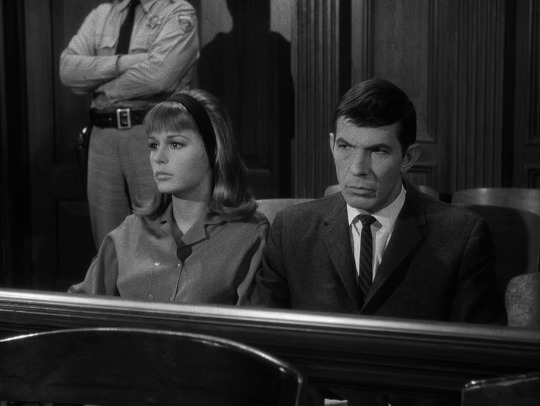
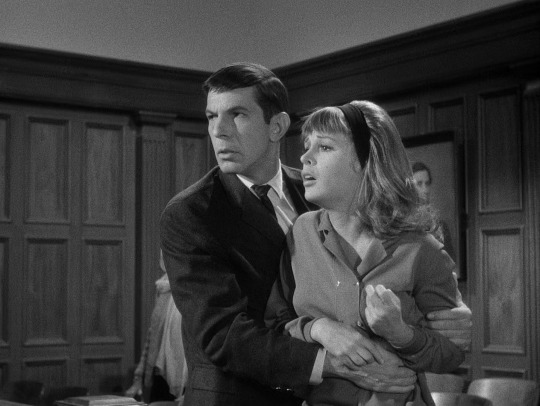
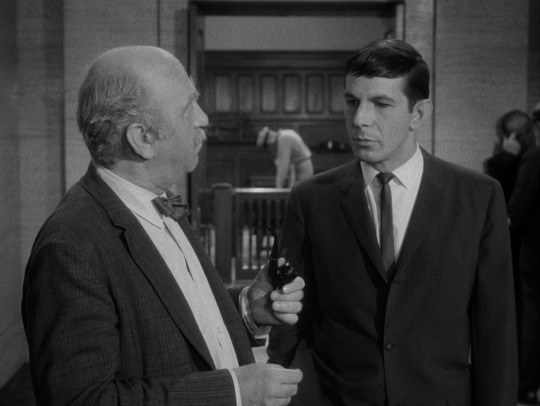

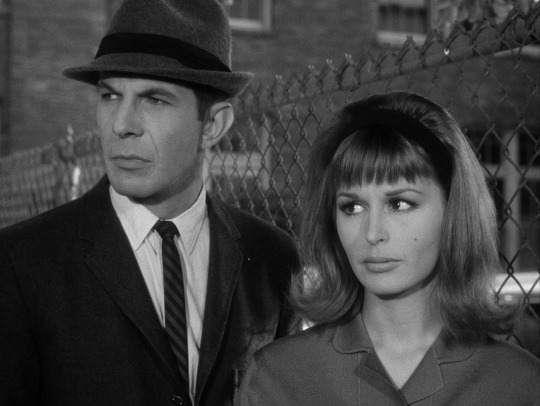
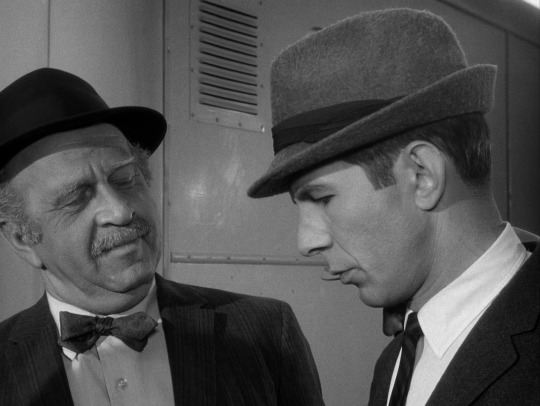
Today in the Department of Before They Were Star Trek Stars, Part 2 of a double feature! Like the last episode of The Outer Limits, this episode had too many good shots and too many Trek connections to fit comfortably in one post. Leonard Nimoy guest stars in "I, Robot," episode 9 of the second season of The Outer Limits (original air date Nov 14, 1964).
Nimoy plays a journalist covering the story of a robot on trial, accused of the murder of his creator. The story has elements of a space-age retelling of Frankenstein, as well as the ethical issues surrounding the creation of artificial life that Star Trek has been exploring for nearly sixty years, and human society is still wrestling with today. As Nimoy's character says at the end of the episode, “It's not the end of the story. It's just the beginning.”
Other Trek Connections:
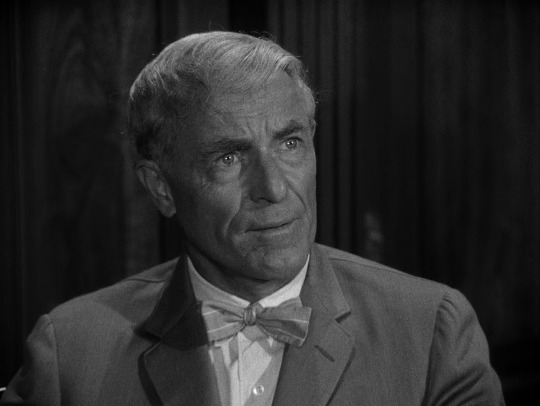
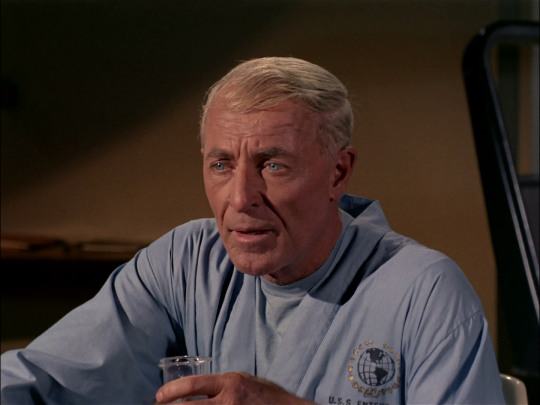
John Hoyt plays a colleague of the deceased scientist, who testifies as an expert witness. He went on to play Dr. Philip Boyce, the Enterprise's chief medical officer in the Star Trek pilot “The Cage” and its repackaged version “The Menagerie.”
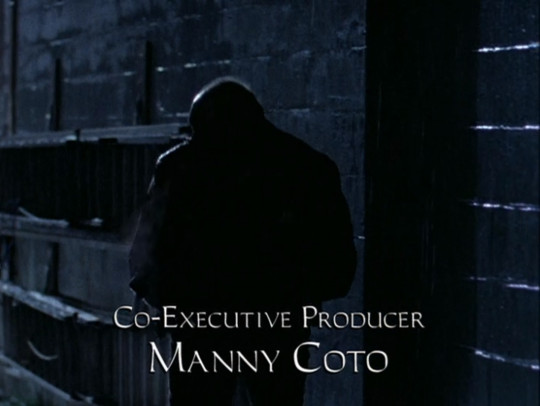
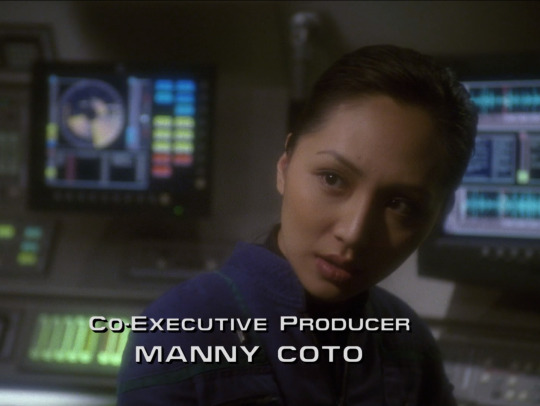
“I, Robot” was remade as the 18th episode in the 1995 reboot of The Outer Limits. Leonard Nimoy played the role Howard da Silva played in the original, and Adam Nimoy directed. Manny Coto served as an executive producer on this series and on Star Trek: Enterprise (he also wrote or co-wrote 14 episodes of the latter).
#star trek#star trek tos#star trek the original series#star trek enterprise#the outer limits#1960s tv#tv sci fi#tv anthology series#leonard nimoy#howard da silva#peter brocco#marianna hill#john hoyt#adam nimoy#manny coto
31 notes
·
View notes
Text
I'm answering these via text again because it would take way too long otherwise!
read the screencaps of that one really nasty transradfem you rb'd a little earlier and you know what struck me in particular is, especially as they went on (there were many) it was so interesting seeing how many of them used text like "trans women" almost exclusively for trans women but trans men/mascs got almost exclusively called 'tboys' 'they/hes' 'tmes' 'theyfabsbians (???)' and 'aidans' and not once just called trans men. and i wonder if theres some part of them that is aware of how bad that would look. how much more spiteful that would seem. or at least more obviously full of shit. or maybe its just self-righteous rage idk. it doesn't REALLY matter WHY, its just stomach-curdling dehumanization and its suuuch a bummer. anyway youre great as ever! have a good weekend :)
It's so fucking gross and weird, and blatantly transandrophobic specifically in a way that's undeniable.
The conversations around it have cooled down, but it was disconcerting seeing people act like the reaction to intersex people in athletics is purely transphobic (and only impacting intersex athletes incidentally), when one of the people actually supporting rulings against intersex women is Joanna Harper, a trans woman and scientist. She has previously testified against Caster Semenya on behalf of World Athletics. I support Harper's work in arguing for trans women's inclusion in sport. It is vitally important. I do not wish ill on her whatsoever. But she showcases the huge intersexism problem the wider trans community has, which needs to be more widely acknowledged. ("Hyperandrogenism and women vs women vs men in sport: A Q&A with Joanna Harper" is perhaps the most illustrative example of her views.)
Also, you straight-up have countless numbers of radfems and other transphobes taking the intersex argument into account wrt Imane Khelif and going "yeah well he's still a male sweetie :)" so it's not like you can even say her situation specifically was about trans women even if that was a large part of it.
this isnt a trans related thing but i know you answer asks often so apolgies in advance do you ever get so excited that you just dont do something? like, not "oh i dont have the energy/cant focus/ect" but your just so excited to do something that you literally can't? i'm having that with some videos i wanna watch and its like pleaseeee i just wanna watch themmmm but now i've been plagued with energy
sorry, anon with to much energy again, would like to add i'm not sure if i have adhd or not but i'm leaning towards no cause it would be really inconvenient if i did and also this happens with literally everything not just videos, books, youtube vids(rn), tv shows, games idk how to end this so have a good day!
My problem is definitely in the opposite direction, I never have enough energy. Would that we could switch.
So I will say iirc social murder is a legitimate concept that's typically used to describe the ways that vulnerable populations are quietly killed under the guise of "letting die" such as putting DNRs on disabled patients during covid who had no desire for and indeed no idea they had effectively been marked as "acceptable to let die". It goes along with stuff like abjectification aka a demographic is made into not simply an object or non-human but a monster worthy of being put down. The abjectification of Palestinians is what allows the state of israel to say explicitly or implicitly things like "there are no innocent civilians" Sorry if there's any typos I've missed ^^;;
Pervious anon again to also clarify that social murder is something done systematically and can be done by omission too like the way in which adoptees especially trans racial & international adoptees face higher rates of suicide, risk of harm fron caregives, and medical issues that go treated bc of a lack of family medical history bc were just seen as ungrateful for wanting contact with our families of origin even if it's SOLEY for getting our medical records
Trans ppl of all kinds experience social murder through medical neglect, domestic/caregiver/workplace violence and though omission via lack of legal protection/trans panic defense stuff. Social murder is not something one individual does to another individual though individuals do uphold the systems that allow social murder...it's very uncomfortable to be part of the demographics that are subject to these quiet "letting die" situations and fear that we'll become a statistic and then have ppl try to turn it into an interpersonal gotcha for lateral aggression / separatist purposes so like ty for trying to course correct that Again sorry if we missed any typos and we think your really cool ^^;;
I think that's just a similar name for an entirely different concept, though. I don't know to what extent "social murder" is or was used outside of transradfem circles to mean "canceling but like, evil" but it was the first time I heard either the phrase or that context.
hey as a trans man I just wanted to let you know I really really appreciate your blog and you standing with us, I hope we can all endeavour to stand by each other in times like this. we're stronger together than apart and every trans person, regardless of identity, deserves to have a voice.
It's always my pleasure, anon.
nice transandrophobic opinion, nerd. did you get it from your favorite tankie blogger?
lmao fr I need to start using that
Miss Velvet, I am unfollowing, flambéing, blocking, etc for your dragon ball takes! …just kidding. I love your posts.
I have all the right takes.
youre so cool
I knowwwwww
such a weird assumption that trans women cant be into detrans kink too?? my trans girlfriend was into it and even if i personally wasnt i like being a kink sponge so she could get it all out on me
It's especially bullshit because the coiner of transandrophobia was crucified for a indulging a trans woman with a detrans kink.
out of curiosity. any thoughts on cannibalism? hypothetically of course. fantasy only
Not my thing, although I think the metaphysical idea of incorporating what you eat into your spirit somehow is fascinating.
I checked the post and I'm not seeing ops letting terfs call trans women rapist in the replies Like its not there They were just offline and can't be online to block every shit terf that speaks every three seconds. Also love how that person remived rbs after u saw the post bc they know theyre lying and pretending they're being "dogpiled"
I relaize I might just have all the terfs blocked but my point stabds: this person probably isnt chronically online to argue with every terfs who makes up lies. i sometimes just ignore them bc yhe obly terfs i worry about are the ones who say that shit in real queer spaces an noth their pathetic little blogs
Yeah, like. The idea was that they were deleting one group of radfems and not the other and that just wasn't true. So frustrating, but them killing the reblogs is hilarious as always.
14 notes
·
View notes
Text
"It struggles but it still obeys" -- OPM webcomic chapter 150 review
Summary
The trap we've been waiting to see sprung has finally started to close. Everywhere we look, the triumphant Neo Heroes are stopping, stuttering, and freezing, their pupils fixed and dialated like a corpse's. Then, they move, reanimated to a new existence, one they have no control over. Only lucky individuals who've modified their suits in some way -- or had them broken -- have escaped. And as Accel, Puri Puri, and Amai Mask will testify, the new Neo Heroes attack former allies savagely on sight.
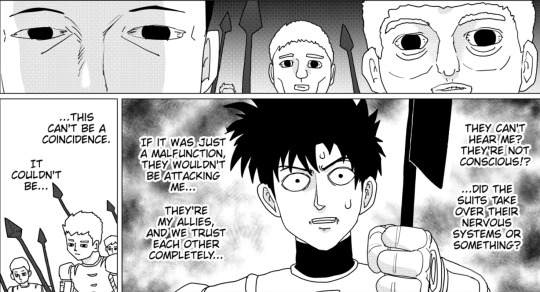
Elsewhere, we see Genos encounter 'Boros's' brain-dead corpse. It has been kept functional on life support in the second of Metal Knight's labs. Noting that the creature is an incredibly powerful one that can't be allowed to rampage. Genos nevertheless feels for it: it's being kept alive to fight. Like him. While Google Translate isn't the best, the translation it comes up with, of Genos saying that at least one of them should have an easy escape when he moves to kill 'Boros', really hits hard.
We see how clearly Genos sees the situation he's in. The rampaging cyborg screwed him out of his past and any social context. Dr Kuseno screwed him out of a future. And now Saitama, the lackadaisical, uncaring Saitama, has been screwing him out of any chance to salvage anything of value out of his situation. Damn straight he's angry.* And in a hurry. There better be a kindly deity willing to pour cooling water on Dr Bofoi's soul, for unless there's a miracle of understanding to stay Genos's hand, that soul is about to be parted from its body with flames so hot it'll arrive in the afterlife still on fire.

Speaking of the lackadaisical Saitama, he's been doing a good job of eliminating the robots wherever he's encountered them. Blue follows the trail of the storm of robot parts he's been flinging hither and thither and accidentally gets steam-rollered by Saitama. That's where the chapter ends.
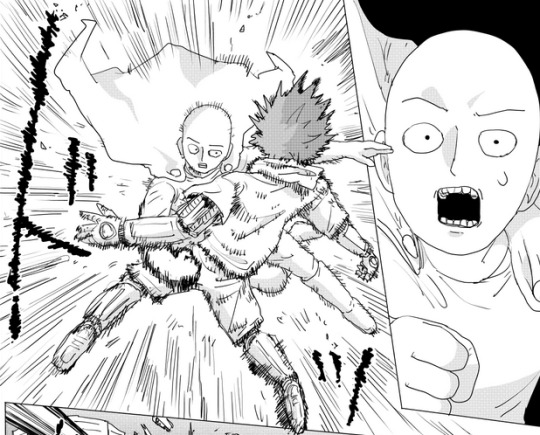
When we'll continue, your guess is as good as mine.
Meta
Insects. That's all that people are worth to The Organization. It's been nearly three years since I first pointed out the difference between the cyborgs we'd been seeing to date to what the Neo Heroes were doing. I brought up this harrowing reality of using insects as cyborgs and forcing them to move according to an operator's instructions:
youtube
"It struggles but it still obeys," is what the lead scientist says. In the story, we see human beings living this reality. Raiden must have incredible willpower: despite everything, he's able to stutter a few words to Puri Puri, begging the latter to save him from his torment even as he rains blows down on the hero.
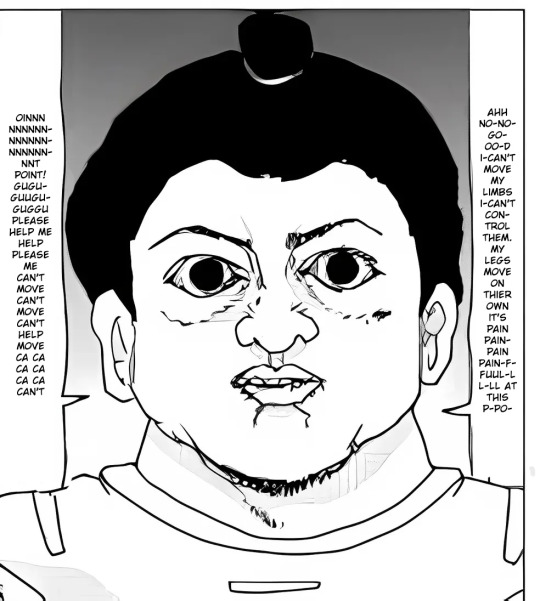
Link: https://www.reddit.com/r/OnePunchMan/comments/1agdu1y/translation_of_raidens_muttering_webcomic_spoiler/
For luckless souls who fall into the tender mercies of Erimin and Destro and their 'recovery' capsules, there's an even crueler fate waiting. I'll save that for another day. We'll find our way back to what's happening at Neo Hero HQ in time.
Yes, we the readers have been sitting on high being fed the answers to the evil behind the Neo Hero facade. We may not know who is ultimately responsible, and we may not yet know why, but we know a lot and a lot looks 'obvious' to us. However, the characters in the story can only discover the reality based on the evidence they actually have access to and what they already know/think. ONE is very strict on rules of evidence. If it's taken various individuals until now to start to know, it's not because they're stupid. Never think that, oh person given the answers from the back of the book.

The question is what are the individuals who have begun to understand what's happening going to do? They're all scattered in a deeply hostile and dangerous world -- and there isn't much time to do something before civilization is too broken and cowed to function.
That is, of course, the most urgent problem. Speaking of saving civilization, is the Hero Association going to be saved? But there are other urgent problems. Like, one cannot help but worry that Dr. Bofoi is the wrong target to eliminate. He surely deserves some karma but it may well be a gross miscarriage of justice. What's going to happen there? What's going to happen with 'Boros' (I'm not going to take away the quotations until the critter has a mind of his own again)? And really, who truly is behind all this and what do they want?
Tune in sometime in the future to find out.
Aside
*Yes, I have a lot more to say about this, but I need first to set the context to what I'm going to say. So look for additional meta. Nag me if I'm tardy!
#OPM#OPM webcomic#meta#review#oh this really is all kicking off#and we know there are more revelations to come by#not to mention a lot more grisly action#I'd be on the edge of my seat but ONE has trained me too well#Youtube
52 notes
·
View notes
Text
OK SO
I had a dream that Miles Edgeworth from Ace Attorney was close friends with Barry Allen from DC Comics. And knew he was The Flash. Like, Barry is a forensic scientist so he worked with Edgey who just figured it out. The two became as close as brothers. I think they met during Bratworth era but I'm not sure the dream did not let me know, only that they were as close as Phoenix is to Edgey (and I headcanon them being as close as brothers so...)
This is obviously after Investigations 2 because Edgey took in Sebastian Debeste. And yeah Barry basically became friends with him to, and Sebby became friends with Wally West but that isn't relevant.
Anyway, so Barry takes his two friends to the Justice League Watch Tower. There's only Green Lanterns. Then everyone passes out and a Lantern from another planet is DEAD and all evidence seems to point to Sebby.
So naturally everyone is warped to another planet. Edgeworth tries to contact Phoenix but this is taking place during the Professor Layton crossover so he's baking bread with Maya. So Hal Jordan, a Green Lantern, decides to defend Sebby but this guy is not a lawyer. Edgeworth acts as assistant to him, and Barry is forced to be the detective.
Hal messes up a bit by asking for the sentence to be reduced because his client is a minor. This makes people upset, but the prosecutor laughs. The judge reveals that the punishment is more severe if the person is a minor, and it was already execution so it's just like, painful execution so he thanks the defense and the Prosecutor laughs very hard.
I don't remember many details of the case but it was ridiculous, emotional, 3 days long, and gave final case of a game vibes
Turns out the prosecutor was the culprit, and THE REVERSE FLASH IN DISGUISE BECAUSE THIS GUY DECIDED TO USE HIS SUPER POWERS TO FRAME BARRY'S FRIEND FOR A CRIME THAT WOULD RESULT IN DEATH, AND MAKE BARRY TESTIFY AGAINST HIM BECAUSE THIS MAN HATES BARRY AND LOVES TO MESS WITH HIM.
He says he has a backup plan in case the trial was lost, but then PHOENIX CALLS EDGEWORTH. Edgeworth tells him not now but Wright stays on the line. Reverse Flash reveals he placed bombs all over this planet that will explode in one minute and as the Lanterns deal with that alongside Flash he kidnaps the two regular humans to make Flash do a "You can only save one thing"
Edgy drops the phone as he is taken and now Hal has to explain to Phoenix what the heck is happening while also diffusing bombs and then I woke up!
Also Phoenix apparently doesn't think superheros exist
26 notes
·
View notes
Text
back when we were doing dracula daily, someone posted something about how van helsing was both a lawyer and a doctor, and i was like “?? but jack is also both?”, but when i tried to find support for this idea of mine, i couldn’t find it. eventually i resigned myself to it being something i had dreamt.
but then!! i was again rereading the october 1st passage, where renfield says:
[…] I am as sane as at least the majority of men who are in full possession of their liberties. And I am sure that you, Dr. Seward, humanitarian and medico-jurist as well as scientist, will deem it a moral duty to deal with me as one to be considered as under exceptional circumstances.
and this is where i had gotten the idea, i think. but a medico-jurist is not a lawyer, which i had assumed because of the word jurist. no, a medico-jurist is, as the name implies, someone who’s involved in medical jurisprudence.
from wikipedia (awkwardly abridged for convenience):
Medical jurisprudence or legal medicine is the branch of science and medicine involving the study and application of scientific and medical knowledge to legal problems, such as inquests, and in the field of law. […] medicolegal cases involving death, rape, paternity, etc. require a medical practitioner to produce evidence and appear as an expert witness, […] Medical jurisprudence includes […] questions of competence or sanity in civil or criminal proceedings.
(emphasis mine)
so… our boy jack is out here giving expert witness testimonies in court?
now, i will admit to being someone who’s interested in true crime, and historical cases are always of interest because of the continuous evolution of forensic science and the shifting ideas around diminished responsibility. looking at the late 18th century and the 19th century, there are two points of interest regarding cases in the uk where defendants were found not guilty by reason of insanity:
1. a lot of them where kept at bethlam or broadmoor, famous mental hospitals
2. a lot of the expert witnesses were doctors and superintendents at bethlam or broadmoor, or at times at private asylums
some names that pop up a lot are:
william orange (superintendent at broadmoor)
sir william charles wood (superintendent at colney hatch, with its own connection to seward, later at bethlem)
edward monro (doctor at bethlem, appeared as an expert witness up to around 400 times!)
sir alexander morison (doctor at bethlem)
forbes winslow (owner of his own private asylums, also funniest middle name ever: benignus)
i’m not gonna ascribe nefarious motives to these doctors (especially dr. winslow because he seems to have been a pretty good guy who was “cutting-edge” by treating his patients humanely uhhh) but i still think there was a lot of potential for a conflict of interest, which is why i pointed out their professional positions.
but there is one doctor i will ascribe possible nefarious motives to: our dear doctor jack seward.
i know i’m not the only one who thinks that he was “saved” by the narrative in that in gave him a purpose and a stronger anchoring to his friends (both old and new). considering his opening entry, where he’s like “of course i wouldn’t experiment on renfield, that would be unethical and send me to hell…. but what if?? 👀” like, this guy… this guy!! i say this with love, but he’s primed for becoming an evil scientist.
i don’t think he would have done it when we meet him in the novel, or afterwards when he’s been through the whole adventure/mission – but if the events of dracula hadn’t happened, i could definitely see him descending deeper into self-justified malpractice, by which i mean he’d testify that accused criminals are insane just to get his hands on them, to be able to study them.
but aside from my speculation about that^ i also wonder if perhaps he’s well on his way to becoming an eminent expert witness when we meet him in the book. by renfield’s words, it would seem that he has been involved in an inquest or legal case at least once (but probably more if he’s going to claim the title medico-jurist). we all wonder sometimes how a 29 year old doctor came to have an immense lunatic asylum under his care, but honestly, some of these trials were huge, and expert witnesses could rise to some prominence and gain benefactors that way (just like they do today).
and who knows, maybe jack got his foot in the courtroom door via his lordling friend arthur, which would allow him to establish himself as a medical expert despite being young and (presumably) recently graduated.
#another fun post i decided to keep in my drafts for four months for no reason#jack seward#dracula#meta#ish??#ask to tag#also some of those doctors were like nepo babies fr and had connections to the royal family etc#so they were incredibly powerful and protected#my meta
75 notes
·
View notes
Text
“If it is the fulfillment of man’s primordial dreams to be able to fly, travel with the fish, drill our way beneath the bodies of towering mountains, send messages with godlike speed, see the invisible and hear the distant speak, hear the voices of the dead, be miraculously cured while asleep, see with our own eyes how we will look twenty years after our death, learn in flickering nights thousands of things above and below this earth no one ever knew before; if light, warmth, power, pleasure, comforts, are man’s primordial dreams, then present-day research is not only science but sorcery, spells woven from the highest powers of heart and brain, forcing God to open one fold after another of his cloak; a religion whose dogma is permeated and sustained by the hard, courageous, flexible, razor-cold, razor-keen logic of mathematics.
“Of course there is no denying that all these primordial dreams appear, in the opinion of nonmathematicians, to have been suddenly realized in a form quite different from the original fantasy. Baron Münchhausen’s post horn was more beautiful than our canned music, the Seven-League Boots more beautiful than a car, Oberon’s kingdom lovelier than a railway tunnel, the magic root of the mandrake better than a telegraphed image, eating of one’s mother’s heart and then understanding birds more beautiful than an ethologic study of a bird’s vocalizing. We have gained reality and lost dream. No more lounging under a tree and peering at the sky between one’s big and second toes; there’s work to be done. To be efficient, one cannot be hungry and dreamy but must eat steak and keep moving. It is exactly as though the old, inefficient breed of humanity had fallen asleep on an anthill and found, when the new breed awoke, that the ants had crept into its bloodstream, making it move frantically ever since, unable to shake off that rotten feeling of antlike industry. There is really no need to belabor the point, since it is obvious to most of us these days that mathematics has taken possession, like a demon, of every aspect of our lives. Most of us may not believe in the story of a Devil to whom one can sell one’s soul, but those who must know something about the soul (considering that as clergymen, historians, and artists they draw a good income from it) all testify that the soul has been destroyed by mathematics and that mathematics is the source of an evil intelligence that while making man the lord of the earth has also made him the slave of his machines. The inner drought, the dreadful blend of acuity in matters of detail and indifference toward the whole, man’s monstrous abandonment in a desert of details, his restlessness, malice, unsurpassed callousness, money-grubbing, coldness, and violence, all so characteristic of our times, are by these accounts solely the consequence of damage done to the soul by keen logical thinking! Even back when Ulrich first turned to mathematics there were already those who predicted the collapse of European civilization because no human faith, no love, no simplicity, no goodness, dwelt any longer in man. These people had all, typically, been poor mathematicians as young people and at school. This later put them in a position to prove that mathematics, the mother of natural science and grandmother of technology, was also the primordial mother of the spirit that eventually gave rise to poison gas and warplanes.
“The only people who actually lived in ignorance of these dangers were the mathematicians themselves and their disciples the scientists, whose souls were as unaffected by all this as if they were racing cyclists pedaling away for dear life, blind to everything in the world except the back wheel of the rider ahead of them.”
—Robert Musil, The Man Without Qualities
(Bold emphasis mine.)
Read this absolutely brutal Musil passage soon after joking to my lover: You mathematicians are the unacknowledged legislators of the world! (An obvious reference to Shelley’s 1821 dictum that "poets are the unacknowledged legislators of the world.”)
This passage is for all of you out there who are suffering from AI vertigo. They say generative AI will make humans more “efficient.” What is all this efficiency for? Technology has been evolving at breakneck speed since the industrial revolution and we are still working just as long and hard. Efficiency has become our bondage.
Also... What the fuck does "eating of one’s mother’s heart and then understanding birds" mean? Love it, especially after reading about heart eating in medieval literature...
#Robert Musil#The Man Without Qualities#literature#capitalism#industrialization#mathematics#technocracy#technology
89 notes
·
View notes
Text
By: Richard Dawkins
Published: Jul 26, 2023
In 2011, I was invited to guest edit the Christmas double issue of the New Statesman. I enjoyed the experience, which involved a visit to Christopher Hitchens in Texas to conduct what turned out to be his last interview. I didn’t ask him, “What is a woman?” In 2011, it wouldn’t have occurred to anyone to ask such a daft question. Today it is hurled at embarrassed and perplexed politicians, in tones that are challenging to the point of belligerence. It isn’t hard to imagine Hitchens’ response if he could be asked it today.
My main contribution to that Christmas issue was a long essay on “The tyranny of the discontinuous mind”. Everywhere you look, smooth continua are gratuitously carved into discrete categories. Social scientists count how many people lie below “the poverty line”, as though there really were a boundary, instead of a continuum measured in real income. “Pro-life” and pro-choice advocates fret about the moment in embryology when personhood begins, instead of recognising the reality, which is a smooth ascent from zygotehood. An American might be called “black”, even if seven eighths of his ancestors were white.
Anthropologists quarrel over whether a fossil is late Homo erectus or early Homo sapiens. But it is of the very nature of evolution that there must be a continuous sequence of intermediates. You can vote on your 18th birthday but not before, as though the stroke of midnight signals a quantum leap in your political competence. Universities award first-, upper second-, lower second- and third-class degrees, even though everyone knows that the top of any one class is much further from the bottom of the same class than it is from the bottom of the class above. There are Oxford dons with faith in something they call “the alpha mind”, a Platonic “ideal form”, like a perfect triangle hanging pristine and aloof above messy reality.
If the editor had challenged me to come up with examples where the discontinuous mind really does get it right, I’d have struggled. Tall vs short, fat vs thin, strong vs weak, fast vs slow, old vs young, drunk vs sober, safe vs unsafe, even guilty vs not guilty: these are the ends of continuous if not always bell-shaped distributions. As a biologist, the only strongly discontinuous binary I can think of has weirdly become violently controversial. It is sex: male vs female. You can be cancelled, vilified, even physically threatened if you dare to suggest that an adult human must be either man or woman. But it is true; for once, the discontinuous mind is right. And the tyranny comes from the other direction, as that brave hero JK Rowling could testify.
Sex is a true binary. It all started with the evolution of anisogamy – sexual reproduction where the gametes are of two discontinuous sizes: macrogametes or eggs, and microgametes or sperm. The difference is huge. You could pack 15,000 sperm into one human egg. When two individuals jointly invest in a baby, and one invests 15,000 times as much as the other, you might say that she (see how pronouns creep in unannounced) has made a greater commitment to the partnership.
Anisogamy is the rule in most animals, but it hasn’t always been so. Some primitive animals and plants are still “isogamous”: instead of macrogametes and microgametes, they have medium-sized (iso)gametes. Both partners contribute equally to the joint investment. To make a viable zygote you need the sum of two isogametes, each worth half a zygote. The same requisite sum can be achieved if one partner contributes a slightly smaller isogamete, but this will work only if the other partner chips in with a larger isogamete to redress the shortfall. You could say the minority investor is exploiting the partner who commits the larger gamete.
You can perhaps see where this argument is going, and it has indeed been modelled mathematically. Isogamy is unstable. Under plausible conditions, we get runaway evolution towards some individuals making smaller and smaller gametes, while others go in the other direction, making larger and larger gametes. At the end of the runaway, we now have microgametes that actively seek out macrogametes, and they evolve wriggling tails to propel their pursuit. Macrogametes are in demand, and have no need to go out looking for microgametes. Because microgametes are so small, individuals who make them can afford to make many. Macrogametes have to be few because, as economists love to say, there’s no such thing as a free lunch. The imbalance also means that microgamete producers (“he/him”) can mate with lots of different macrogamete producers (“she/her”), deserting each one in turn. Or they can sequester for themselves a harem of she/hers. There’d be no point in a she/her gathering a harem of he/hims around her: she doesn’t have enough macrogametes to benefit.
The anisogamy binary furnishes the oldest and deepest way to distinguish the sexes. There are others, but they are less universally applicable. In mammals and birds, you can do it with chromosomes. Each body cell of a normal human has 46 chromosomes, 23 from each parent. Among these are two sex chromosomes, called X or Y, one from each parent. Females have two Xs, males one X and one Y. Any mammal with a Y chromosome will develop as a male. When a male makes sperm (“haploid”, having only one set of 23 chromosomes), 50 per cent of them are Y sperm, destined to beget sons, and 50 per cent are X sperm, which make daughters. Birds and butterflies have a similar system, but the other way around. It is females that have XY, except that they’re called ZW. In flies, the equivalent of the Y chromosome is a zero. If a fly has two sex chromosomes she’s female. A fly with only one sex chromosome is male. Many reptiles use temperature instead of chromosomes. Turtles that are incubated below 27.7°C develop as male, warmer eggs as female.
Clownfish determine sex not by temperature but by dominance. All but one of the members of a group are male, and like many animals they sort themselves into a dominance hierarchy. There is only one female in the group. When she dies, the dominant male changes sex and becomes the female. What this means in gametic terms is that his testes shrink and ovaries grow instead. The principle of binary sex at the level of micro- and macro-gametes is maintained. Hermaphrodites such as earthworms and land snails have testes and ovaries all in the same body at the same time. Snails are capable of exchanging sperm both ways, having first violently fired harpoons into each other. Angler fish also have both male and female organs in the same body. But it comes about in a curious way. Males are diminutive dwarves; they locate a female, sink their jaws into her body wall, and then become part of her as no more than a tiny testicular excrescence.
In mammals, including humans, there are occasional intersexes. Babies can be born with ambiguous genitalia. These cases are rare. The highest estimate, 1.7 per cent of the population, comes from the US biologist Anne Fausto-Sterling. But she inflated her estimate hugely by including Klinefelter and Turner syndromes, neither of which are true intersexes. Klinefelter individuals have an extra X chromosome (XXY) but their Y chromosome ensures that they are obvious males, producing microgametes, albeit from reduced testes. Turner individuals are unambiguous females with no Y chromosome and only one (functioning) X chromosome. They have a vagina and uterus, and their ovaries, if any, are non-functional. Obviously, Klinefelter (always male) and Turner (always female) individuals must be eliminated from counts of intersexes, in which case Fausto-Sterling’s estimate shrinks from 1.7 per cent to less than 0.02 per cent. Genuine intersexes are way too rare to challenge the statement that sex is binary. There are two sexes in mammals, and that’s that.
But what about gender? What is gender, and how many genders are there? It is now fashionable to use “gender” for what we might call fictive sex: a person’s “gender” is the sex to which they feel that they belong, as opposed to their biological sex. In this meaning, “genders” have proliferated wildly. When I last heard, there were 83. But that was yesterday. What does “gender” actually mean?
Language evolves, and many words change their meaning on a timescale of centuries. But “gender” has been fast-tracked. It is primarily a linguistic technical term. Linguists classify words of a given language according to such things as the suffixes on adjectives that qualify them, or their agreeing pronouns and articles. All French nouns follow either le or la. They take different pronouns, and adjectives agree with them in a gendered way (le chapeau blanc but la robe blanche). Normally (there are exceptions, such as la souris for a mouse of either sex) males are le and females la. This makes it convenient to use the label “masculine” for le words and “feminine” for la words. Table is a feminine word, but French speakers don’t think of a table as a female piece of furniture. It’s just a la word. Lithuanian also has two genders, but possessive pronouns agree with the gender of the possessor (as in English) whereas in French they agree with the gender of the object possessed. Estonian has only one gender, which I suppose means no gender – the very idea of gender is meaningless. Some Bantu languages such as Nyanja, the dominant language of my childhood home of Malawi, have many. Steven Pinker’s The Language Instinct quotes Kivunjo as having 16 genders. These are not 16 sexual identities, they are 16 families of nouns classified according to how verbs agree with them.
In English, as in French, gender and sex align. All female animals are of feminine gender, all males are masculine, all inanimate things are neuter (with whimsical exceptions such as ships and nations, which can be feminine). Because of the perfect correlation between sex and gender in English grammar, it was natural for English speakers to adopt “gender” as a genteel euphemism for sex: “Sam is of female gender” sounded more polite than “of female sex”.
But that convention recently gave way to another one. The fashion for females to “identify as” male and for males to “identify as” female has emplaced an assertive new convention. Your genes and chromosomes may determine your sex, but your gender is whatever floats your boat: “I was assigned male at birth, but I identify as a woman.” Finally, the wheel turns full circle, and self-identification has now gone so far as to usurp even “sex”. A “woman” is defined as anyone who chooses to call herself a woman, and never mind if she has a penis and a hairy chest. And of course this entitles her to enter women’s changing rooms and athletic competitions. Why should she not? She is, after all, a woman, is she not? Deny it and you are a transphobic bigot.
High priests of postmodernism teach that lived experience and feelings trump science (which is just the mythology of a tribe of oppressive colonialists). Catholic (but not Protestant) theologians declare that consecrated wine actually becomes the blood of Christ. The dilute alcohol solution that remains in the chalice is but an Aristotelian “accidental”. The “whole substance” (hence the word “transubstantiation”) is divine blood in true reality. In the new religion of transsexual transubstantiation, a “woman’s penis” is just an “accidental”, a mere social construct. In “whole substance” she is a woman. A trans-substantiated woman.
Sarcasm aside, gender dysphoria is a real thing. Those who sincerely feel themselves born in the wrong body deserve sympathy and respect. I was convinced of this when I read Jan Morris’s moving memoir, Conundrum (1974). As what she called a “true transsexual”, she distanced herself from “the poor cast-aways of intersex, the misguided homosexuals, the transvestites, the psychotic exhibitionists, who tumble through this half-world like painted clowns, pitiful to others and often horrible to themselves”. Under “misguided” she might have added today’s unfortunate children who, latching on to a playground craze, find themselves eagerly affirmed by “supportive” teachers, and au courant doctors with knives and hormones. See Abigail Shrier’s Irreversible Damage: The Transgender Craze Seducing Our Daughters (2020); Kathleen Stock’s Material Girls: Why Reality Matters for Feminism (2021); and Helen Joyce’s Trans: When Ideology Meets Reality (2021). Many of us know people who choose to identify with the sex opposite to their biological reality. It is polite and friendly to call them by the name and pronouns that they prefer. They have a right to that respect and sympathy. Their militantly vocal supporters do not have a right to commandeer our words and impose idiosyncratic redefinitions on the rest of us. You have a right to your private lexicon, but you are not entitled to insist that we change our language to suit your whim. And you absolutely have no right to bully and intimidate those who follow common usage and biological reality in their usage of “woman” as honoured descriptor for half the population. A woman is an adult human female, free of Y chromosomes.
#Richard Dawkins#biology#human biology#biology denialism#biology denial#gender ideology#identify as#queer theory#reality denial#biological reality#gender studies#religion is a mental illness
25 notes
·
View notes
Text
...Ultimately, the crisis of trust is a crisis of civilization. In May Contain Lies, Edmans recounts an experiment in which subjects are invited to drink apple juice from a bedpan that they know is perfectly clean; 72% of them flatly refuse. This is rational behavior. Heuristics, or rules of thumb, obviate thinking and enable us to live fuller lives. And, as McLean shows, trade is a supremely human activity. Trade enables specialization, and specialization enables the development of knowledge expertise. We all lose when expertise is discredited by being politicized and harnessed to a public policy agenda. A necessary condition for restoring trust in expertise is free expression by experts and nonexperts alike free of intimidation. This condition was absent during the pandemic and continues to this day. It has been absent for many years in discussions on climate change, as both Stuart Kirk and climate scientist Judith Curry, drummed out of her position at Georgia Tech, can testify. Despite the weight of the forces arrayed against them and the power of climate catastrophism to silence dissent, opponents of ESG and stakeholder capitalism have succeeded in checking its advance. True, the battle is lost in the EU and, for the time being, in Britain, but the fact that the CEO of the world’s largest investment manager refrains from using the word “ESG” says something, as does the withdrawal of a number of large financial institutions from climate action groups
3 notes
·
View notes
Text
ChatGPT and the movie ‘Her’ are just the latest example of the ‘sci-fi feedback loop’
by Rizwan Virk, Faculty Associate and PhD Candidate in Human and Social Dimensions of Science and Technology at Arizona State University

In May 2024, OpenAI CEO Sam Altman sparked a firestorm by referencing the 2013 movie “Her” to highlight the novelty of the latest iteration of ChatGPT.
Within days, actor Scarlett Johansson, who played the voice of Samantha, the AI girlfriend of the protagonist in the movie “Her,” accused the company of improperly using her voice after she had spurned their offer to make her the voice of ChatGPT’s new virtual assistant. Johansson ended up suing OpenAI and has been invited to testify before Congress.

This tiff highlights a broader interchange between Hollywood and Silicon Valley that’s called the “sci-fi feedback loop.” The subject of my doctoral research, the sci-fi feedback loop explores how science fiction and technological innovation feed off each other. This dynamic is bidirectional and can sometimes play out over many decades, resulting in an ongoing loop.
Fiction sparks dreams of Moon travel
One of the most famous examples of this loop is Moon travel.
Jules Verne’s 1865 novel “From the Earth to the Moon” and the fiction of H.G. Wells inspired one of the first films to visualize such a journey, 1902’s “A Trip to the Moon.”
The fiction of Verne and Wells also influenced future rocket scientists such as Robert Goddard, Hermann Oberth and Oberth’s better-known protégé, Wernher von Braun. The innovations of these men – including the V-2 rocket built by von Braun during World War II – inspired works of science fiction, such as the 1950 film “Destination Moon,” which included a rocket that looked just like the V-2.
Films like “Destination Moon” would then go on to bolster public support for lavish government spending on the space program.
youtube
Creative symbiosis
The sci-fi feedback loop generally follows the same cycle.
First, the technological climate of a given era will shape that period’s science fiction. For example, the personal computing revolution of the 1970s and 1980s directly inspired the works of cyberpunk writers Neal Stephenson and William Gibson.
Then the sci-fi that emerges will go on to inspire real-world technological innovation. In his 1992 classic “Snow Crash,” Stephenson coined the term “metaverse” to describe a 3-D, video game-like world accessed through virtual reality goggles.
Silicon Valley entrepreneurs and innovators have been trying to build a version of this metaverse ever since. The virtual world of the video game Second Life, released in 2003, took a stab at this: Players lived in virtual homes, went to virtual dance clubs and virtual concerts with virtual girlfriends and boyfriends, and were even paid virtual dollars for showing up at virtual jobs.
This technology seeded yet more fiction; in my research, I discovered that sci-fi novelist Ernest Cline had spent a lot of time playing Second Life, and it inspired the metaverse of his bestselling novel “Ready Player One.”
The cycle continued: Employees of Oculus VR – now known as Meta Reality Labs – were given copies of “Ready Player One” to read as they developed the company’s virtual reality headsets. When Facebook changed its name to Meta in 2021, it did so in the hopes of being at the forefront of building the metaverse, though the company’s grand ambitions have tempered somewhat.
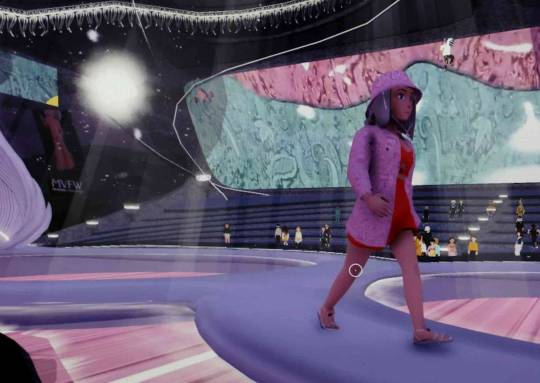
Another sci-fi franchise that has its fingerprints all over this loop is “Star Trek,” which first aired in 1966, right in the middle of the space race.
Steve Perlman, the inventor of Apple’s QuickTime media format and player, said he was inspired by an episode of “Star Trek: The Next Generation,” in which Lt. Commander Data, an android, sifts through multiple streams of audio and video files. And Rob Haitani, the designer of the Palm Pilot’s operating system, has said that the bridge on the Enterprise influenced its interface.
In my research, I also discovered that the show’s Holodeck – a room that could simulate any environment – influenced both the name and the development of Microsoft’s HoloLens augmented reality glasses.
From ALICE to ‘Her’
Which brings us back to OpenAI and “Her.”
In the movie, the protagonist, Theodore, played by Joaquin Phoenix, acquires an AI assistant, “Samantha,” voiced by Johansson. He begins to develop feelings for Samantha – so much so that he starts to consider her his girlfriend.
ChatGPT-4o, the latest version of the generative AI software, seems to be able to cultivate a similar relationship between user and machine. Not only can ChatGPT-4o speak to you and “understand” you, but it can also do so sympathetically, as a romantic partner would.
There’s little doubt that the depiction of AI in “Her” influenced OpenAI’s developers. In addition to Altman’s tweet, the company’s promotional videos for ChatGPT-4o feature a chatbot speaking with a job candidate before his interview, propping him up and encouraging him – as, well, an AI girlfriend would. The AI featured in the clips, Ars Technica observed, was “disarmingly lifelike,” and willing “to laugh at your jokes and your dumb hat.”
But you might be surprised to learn that a previous generation of chatbots inspired Spike Jonze, the director and screenwriter of “Her,” to write the screenplay in the first place. Nearly a decade before the film’s release, Jonze had interacted with a version of the ALICE chatbot, which was one of the first chatbots to have a defined personality – in ALICE’s case, that of a young woman.

The ALICE chatbot won the Loebner Prize three times, which was awarded annually until 2019 to the AI software that came closest to passing the Turing Test, long seen as a threshold for determining whether artificial intelligence has become indistinguishable from human intelligence.
The sci-fi feedback loop has no expiration date. AI’s ability to form relationships with humans is a theme that continues to be explored in fiction and real life.
A few years after “Her,” “Blade Runner 2049” featured a virtual girlfriend, Joi, with a holographic body. Well before the latest drama with OpenAI, companies had started developing and pitching virtual girlfriends, a process that will no doubt continue. As science fiction writer and social media critic Cory Doctorow wrote in 2017, “Science fiction does something better than predict the future: It influences it.”
#science fiction#sci fi movies#artificial intelligence#metaverse#isaac asimov#arthur c clarke#hg wells#open ai#technology#technopolitics#blade runner#blade runner 2049#Youtube
8 notes
·
View notes
Text
Happy birthday to Iona!
Today is her -527th birthday!

Iona is a "smart" AI that was created for use by the Office of Naval Intelligence. She accompanied Spartan-II Black Team on their mission from ONI to destroyed Covenant ships, ultimately destroying an entire fleet.
Seven years later, Iona reached the maximum optimal operational lifespan for a UNSC "smart" AI. After their seventh year, AIs typically began experiencing symptoms of rampancy, developing both functional problems and a break in their personality and objectives, similar to insanity as understood by human beings. Because of this, she was scheduled to be preemptively terminated. Iona took the unprecedented action of seeking to appeal the decision to terminate her through a judicial process, something that caught the attention of scientists at the United Nations Humanitarian Council.
She was given a trial and testified in her defense, declaring that she had a right to live and described her philosophy and even her spirituality, which led her to believe that she could overcome rampancy. After her trial, the judges decided to put her in stasis until they reached a decision. Iona reluctantly agreed, fearful but satisfied that she had her day in court.
The trial was a farce: ONI tasked smart AIs Black-Box and Roland to conduct a fake trial and put Iona in stasis so that both could be studied. While Roland felt guilty about deceiving her, Black-Box observed that even if the trial was simulated, it could still be studied and used to advance the rights of artificial intelligence in the future.
37 notes
·
View notes
Note
the dead can’t hurt you / for ann?? or chishiya, she'd do it for either and still be like 🤷♀️
↳ SEND "lethal protection" FOR MY MUSE TO KILL TO PROTECT YOURS, OR "the dead can't hurt you" FOR YOUR MUSE TO KILL TO PROTECT MINE

Being a forensic scientist and former crime scene investigator put Ann into the world of crime, but the times of ACTIVE danger were almost nonexistent. ( Almost, because she has scars that speak of the occasions the unexpected happened. ) She went out of her way to learn extra skills. But self defense classes aren't set up for situations like this ; when human emotion is PUSHED TO THE EDGE by desperation and anger and pride. There is no promise the people you play games with will appreciate you saving their skin. There is no law to stop violence afterwards. And self defense classes from almost a decade ago aren't quick to resurface, much less in the face of a former veteran charging, lashing out because his plan had been STUPID and people chose HER plan. ( And they won because of it. ) Or maybe he just hated her ; Ann didn't care either way.
It doesn't mean Ann goes easily. Even with hands on her throat, threatening to crush her, she lashes out. ( She's seen TOO MANY dead girls with vacant eyes ; she's photographed too many broken nails with blood and skin cells under them - the EVIDENCE they used to convict attackers who otherwise would have escaped, she's seen and examined and testified to too many dead women who've been in this position and fought to the end no matter how HOPELESS. ) Ann might not be overly keen on violence but all humans have weaknesses, she stabs at his eye an the soft skin of the throat, but its not enough. Instead she's STRUGGLING to draw in air and keep her windpipe open, but the edges of her vision are blurring and growing black.
Her ears are ringing but Ann hears a loud sound and suddenly the weight is gone. She doesn't care about whatever splatters over her face and the crisp white shirt she wears. Ann rolls onto her side and gasps for air, eyes shut to try to help her regain her balance. There's going to be nasty BRUISES where the man's hands were, she already knows that. But she's alive and she's breathing. Ann's eyes slowly open and she finds Pat near, a smoking gun in hand. There's NO RULE you can't take the weapons from games with you. And for once in these lands, Ann's rather glad SOMEONE has a gun. Her chest heaves with the desperate need to fill her body with oxygen and it's only after a few seconds that she slowly props herself up.
" Thanks. " Her usually steadfast voice is HOARSE in the aftermath of the attack, but the certainty of her voice is still there. She turns her head to look at the man - definitely dead. It's not that easy of a feat for someone who's never held a gun which carries with it certain observations, but Ann COULDN'T CARE LESS. There's scrapes on her arms and legs and the obvious injuries to her neck but it could be much, much worse. It would have been if Pat had been much later. " Good thing you took that. " Finally, only then does Ann unsteadily climb back to her feet - doesn't bother to wipe the blood away. / @cartelheir
#cartelheir#PAT HERE TO SAVE THE DAY#thank you pat we appreciate you#just thinking tho how many scenes Ann's seen of things like this#and almost being a victim??#brutal thoughts#01. IN CHARACTER — ANN#V1. DEFAULT VERSE — ANN
3 notes
·
View notes
Text
The Alchemist (No. 101). 👏👏👏 Episode highlights.

Season 1, Episode 12 "THE ALCHEMIST"
LET'S REMINISCE!
Red notifies the team that a man known as the Alchemist has been hired to protect a mob informant and his wife;
Official synopsis: As Red (James Spader) enlists activist whistleblowers in his search for the mole, Liz (Megan Boone) pursues a deranged scientist who's helped dozens of criminals escape by engineering and killing their genetic doubles.
Eric Trettel aka The Alchemist. - Meera: His name’s Eric Trettel. Flunked out of med school. Falsified a degree from Harvard and used it to land a job in the Human Genome Project. He spun that into a career as an expert witness specializing in DNA evidence. Ressler: He testified in a case on behalf of Carlos Trena, a soldier in the D’Angelo crime family facing three counts of murder one. Meera: Trettel was hired to present exculpatory DNA evidence. Problem is, that evidence was falsified. Trettel was outed as a fraud and disgraced. Two weeks later, he disappeared. It was believed either the D’Angelo family had him killed or he fled to avoid indictment.
Liz: He’s, um – a scientist, an expert in DNA.
EPISODE HIGHLIGHTS:
Red: – There’s someone I think you should find.
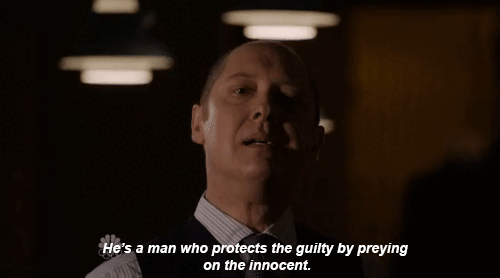
He’s a man who protects the guilty by preying on the innocent. He’s killed women, children, infants if need be– whatever the particular job calls for.
Red: I bring this to your attention because I’ve learned that he’s been contracted to protect Pytor Madrczyk and his wife.
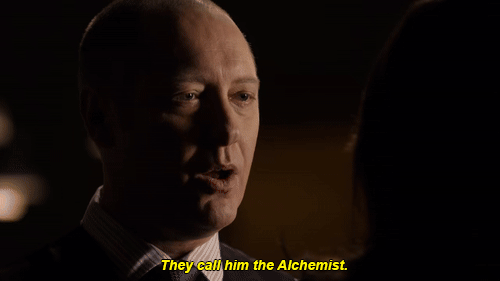






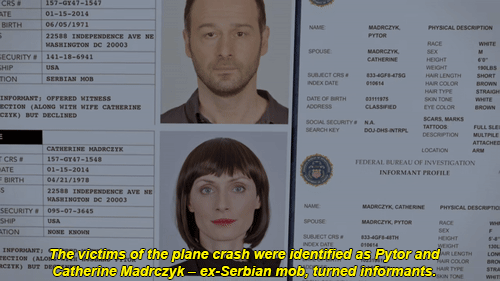
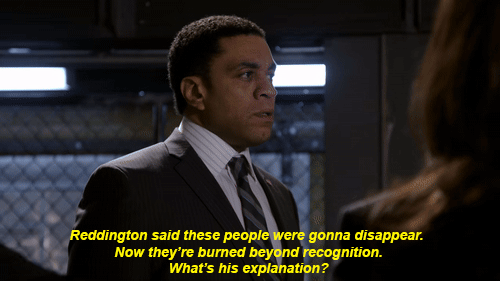
Liz: You were wrong about Madrczyk. You said the Alchemist was hired to protect him. Now he’s dead.
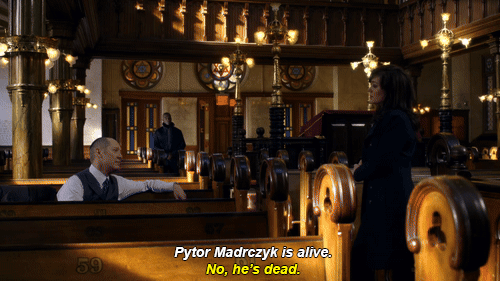



Liz: How does he do it?
Red: I don’t know even half of it. I’ve heard rumors– removing the white blood cells from the victim and replacing them with the red blood cells of his client, leaving clone DNA at crime scenes to mislead the police, even incorporating synthetic DNA into genuine human tissue.
Liz: So this isn’t just evidence tampering. This is genetic manipulation.
Red: Yes. It’s a trade in death. The guilty give their blood and genetic identity.mThe innocent give their life for the guilty to live. If you find the Alchemist, you have a chance to resurrect the dead, to bring to justice some of the most vile creatures who ever lived.
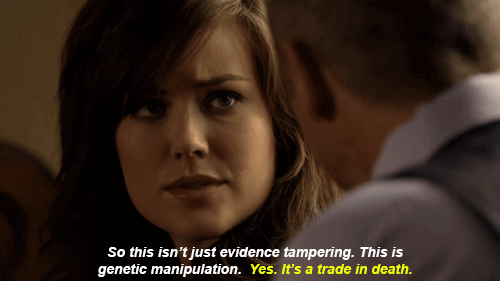
Red: If you find the Alchemist, you have a chance to resurrect the dead, to bring to justice some of the most vile creatures who ever lived.
Aram: The female victim on the plane was named Sarah Jenkins.
Liz: How did you identify her?
Aram: The Alchemist knew that, based on a forensic procedure, we wouldn’t run tests necessary to distinguish between synthesized and natural DNA. Now that we know what we’re looking for, we pulled the bone–marrow sample, ran it against our database.
Mrs Madrczyk: I got a call. Are you Trettel?
Trettel: We have a situation.
Mrs Madrczyk: Yeah, we have a situation. You crashed our jet, murdered five people. We’re supposed to be gone. You assured us. I was on my way to Budapest when my husband was taken into FBI custody.
Trettel: Who did you tell?
Mrs Madrczyk: We paid you to make us disappear.
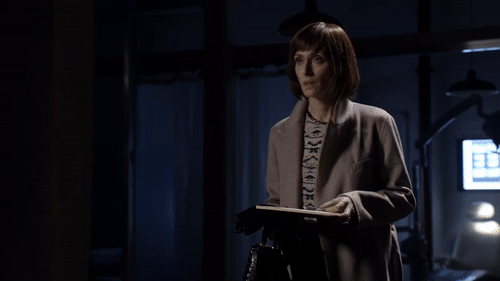


Liz: Sarah Jenkins was using an online–dating site. That’s how we think the Alchemist found her. Gave him everything he needed to know to double her as Catherine Madrczyk.
Liz: He knows we’re onto him.
Ressler: That’s why he took the risk of coming into the field office. Got Madrczyk, his wife– The guy’s killing everybody that might lead us to him.
Liz: Oh, my God. His family.

Ressler: [ On phone ] Malik, we’re too late. Molly and Annie Trettel are dead.
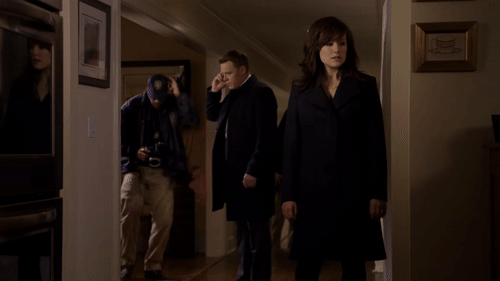
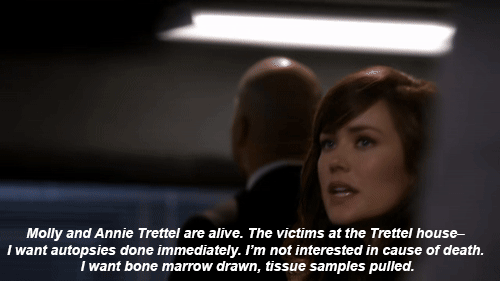
Mrs Trettel: You’re not gonna get away with this.
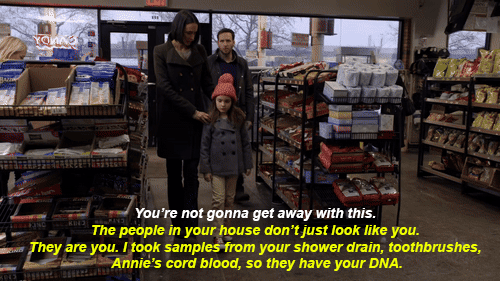
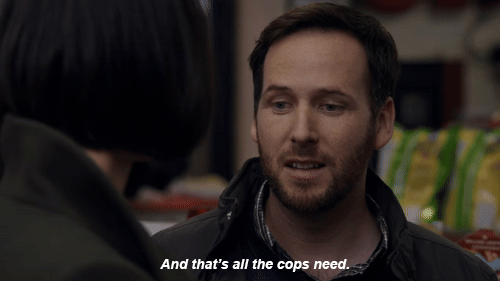
6 notes
·
View notes